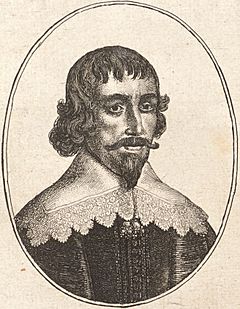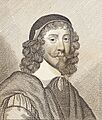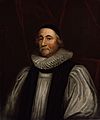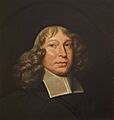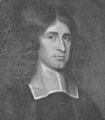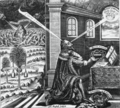History of the Puritans under King Charles I facts for kids
Under King Charles I, a group called the Puritans became very important. They were not just a religious group but also a political one. People who didn't like the king's power joined forces with the Puritans. The Puritans felt the Church of England was moving away from what they believed. They also worried about more Catholic influence in the royal court and the church.
After the First English Civil War, different Puritan groups held power. The trials and executions of William Laud (an archbishop) and then King Charles were huge moments in British history. For a short time, the Puritans, led by Oliver Cromwell and the army, were very strong. But they couldn't agree on how to set up a new religious system for the country. The ideas from the Westminster Assembly became their lasting legacy.
At the same time, many Puritan families and church groups moved to New England in America. This was especially true during the middle years of King Charles's rule.
Contents
Puritans and King Charles I
The 1630s saw big arguments between Puritans and traditional church leaders, called Episcopalians. These arguments were about Laudianism, a set of church practices favored by Archbishop Laud. Before this, in the 1620s, there were similar debates about Arminianism. Puritans strongly disliked Arminianism because it disagreed with some key Calvinist beliefs, especially about Predestination (God's plan for people). They saw it as secretly leaning towards Catholicism. These religious debates became more heated when the Thirty Years War started in 1618. Many people saw it as a wider attack on Protestantism.
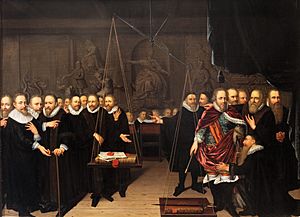
King James I was a Calvinist. He generally supported other Calvinists in the debates between Calvinists and Arminians. He sent a strong group to the 1618–1619 Synod of Dort in the Dutch Republic. He supported their decision to call Arminianism a wrong belief. However, he changed his views a bit when he tried to arrange a marriage between his son Charles and a Spanish princess.
King James died in 1625, and his son Charles became king. Charles did not trust the Puritans. He thought their ideas about church rules and foreign policy were just political games. He also saw them as challenging his own power, which he believed came from God. King Charles wasn't very interested in religious questions himself. But he liked the ideas of William Laud and other church leaders who focused on order, proper ceremonies, and a more traditional, or "High Church," style of worship. His father had supported the Calvinist rules from the Synod of Dort. But Charles stopped Anglican sermons that defended predestination. Where James had been easy on clergy who skipped parts of the Book of Common Prayer, Charles told bishops to make sure everyone followed the rules and to suspend those who refused.
Besides George Villiers, 1st Duke of Buckingham, Charles's closest advisor was William Laud. Laud was the Bishop of St David's. Charles moved him to the better position of Bishop of Bath and Wells in 1626. With Laud's influence, Charles changed the king's church policies a lot.
Early Conflicts with Puritans (1625–1629)
In 1625, King Charles married Princess Henrietta Maria of France. She was the Catholic daughter of King Henri IV. This marriage suggested an alliance with France against Spain. But Puritan members of Parliament openly worried that Charles would ease laws against Catholics. They even feared he might allow Catholics more freedom. The king had secretly agreed to do this in his marriage treaty with King Louis XIII of France.
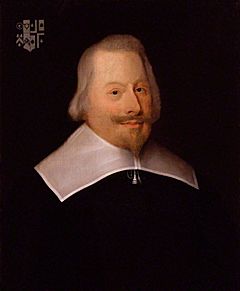
George Abbot was the Archbishop of Canterbury from 1611. He was a mainstream English church leader. He was friendly with Scottish Protestants and against Catholicism in a typical Calvinist way. He also opposed Arminianism. Under Elizabeth I, he had worked with Puritan figures. A debate about Richard Montagu's anti-Calvinist book was still going on when Parliament met in May 1625. Montagu was criticized in Parliament by the Puritan MP John Pym. When Montagu wrote a pamphlet asking for the King's protection, Charles made him a royal chaplain.
Parliament did not want to give Charles money. They feared he might use it to support an army that would bring Catholicism back to England. The 1625 Parliament broke a long tradition. They voted to let Charles collect customs duties for only one year. When Charles wanted to join the Thirty Years' War by fighting Spain, Parliament gave him only a small amount of money. The war with Spain went ahead anyway. Charles collected customs duties even after he was not allowed to. Buckingham was in charge of the war but failed.
The York House conference in 1626 showed how sides were forming. Opponents questioned the Puritans' loyalty, saying their beliefs led to rebellion. In their sermons, Arminians began to support the king. Archbishop Abbot lost his power in 1627. This happened after a disagreement with the king over a royalist clergyman. Richard Montagu was made Bishop of Chichester in 1628.
The war with France (1627–1629) also failed. Parliament asked for Buckingham to be replaced. But Charles stood by him. Parliament then passed the Petition of Right. This document declared Parliament's rights. Charles accepted the Petition, but it did not change his actions.
The King's Personal Rule
In August 1628, Buckingham was killed by a soldier. The public's reaction angered Charles. When Parliament met again in January 1629, Charles faced anger over John Rolle. Rolle was an MP who had been punished for not paying customs duties. The Speaker of the House of Commons was held in his chair. This allowed the House to pass a resolution criticizing the king.
Charles decided to rule without calling Parliament. This period (1629–1640) is known as his Personal Rule. During this time, Laudianism became very strong in England.
What was Laudianism?
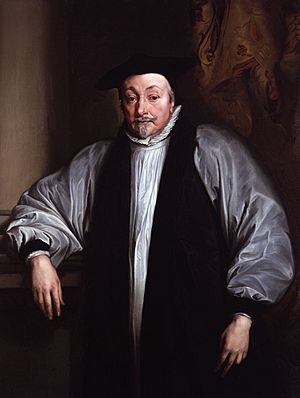
Laudianism was the name for the church policies of King Charles and Archbishop Laud. Its main idea was the "beauty of holiness." This meant a love for ceremonies and orderly church services. Many churches in England had fallen apart after the English Reformation. Laudianism called for making churches beautiful again. Churches were ordered to make repairs and show more respect for the church building.
One policy that Puritans hated was putting altar rails in churches. Puritans linked these rails to Catholic beliefs about the Real Presence of Christ in the bread and wine. In Catholic practice, altar rails marked off a special area. Only priests and altar servers were allowed inside. Puritans also said that kneeling at the altar rail for communion looked too much like Catholic worship. The Laudians insisted on kneeling at communion and receiving at the rail. But they still used the Book of Common Prayer and rejected Catholicism.
Puritans also disliked the Laudian insistence on calling Anglican clergy "priests." To them, "priest" meant someone who offers a sacrifice. They thought this was related to Catholic teaching about the Eucharist as a sacrifice. After the Reformation, Puritans generally used the word "minister" (meaning "one who serves"). They argued for this word or for using the Greek word "presbyter" from the New Testament.
Puritans were also upset when Laudians brought back the custom of keeping Lent. This practice had become unpopular in England after the Reformation. Puritans preferred special fast days called by the church or government for specific problems. They didn't like days chosen by the church calendar.
Puritans Settle in New England (1630–1642)
Some Puritans started thinking about creating their own colony. There, they could worship in a fully reformed church, far from King Charles and the bishops. This was different from the Separatists of Plymouth Colony. John Winthrop, a lawyer, began to explore the idea of a Puritan colony in New England. The Pilgrims at Plymouth Colony had shown that such a colony could survive.
In 1627, a company for New England expansion went out of business. But a new one, the New England Company, took its place. Many of the same people were involved. Throughout 1628 and 1629, Puritans in Winthrop's group talked about moving to New England. The New England Company wanted clearer ownership of the land. In March 1629, they got a royal charter from King Charles. It changed the company's name to the Governor and Company of the Massachusetts Bay in New England. It also gave them the land to start the Massachusetts Bay Colony. The charter didn't say where the company's yearly meeting should be held. This meant the company's governor could move to the new colony and be its governor. The company's general court could become the colony's law-making assembly. John Winthrop was part of these talks. In March 1629, he signed an agreement. It said that shareholders who weren't moving would give control of the company to those who were. Winthrop was the richest of the moving shareholders. So, the company made him governor and gave him the company charter.
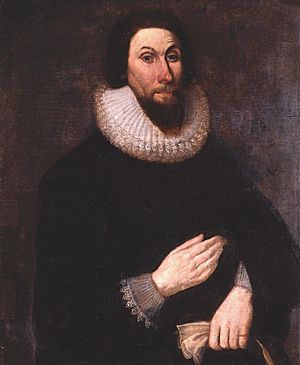
Winthrop sailed to New England in 1630 with 700 colonists. They were on eleven ships, known as the Winthrop Fleet. Winthrop himself sailed on the Arbella. During the trip, he gave a sermon called "A Model of Christian Charity." In it, he told his fellow settlers to make their new colony a City upon a Hill. This meant they would be an example to all of Europe. In 1630, the Thirty Years' War was going badly for Protestants. Catholicism was being brought back in areas that had been reformed.
In December 1634, the king's council officially limited emigration. Only church members who followed the rules were allowed to leave.
William Laud Becomes Archbishop (1633–1643)
In 1633, the moderate archbishop George Abbot died. Charles I chose William Laud to be the new Archbishop of Canterbury. Abbot had been stopped from doing his job in 1617. This happened after he refused to tell his clergy to read the Book of Sports. Charles now re-issued the Book of Sports in October 1633. This was a symbolic act against strict Sunday observance. Laud then ordered his clergy to read it to their congregations. He suspended ministers who refused. This was a way to find and remove Puritan clergy. The 1630s saw bishops trying harder to make the church uniform. They wanted strict obedience to the worship style in the Book of Common Prayer. The Court of High Commission became the main way to punish Puritan clergy who didn't follow the rules. Unlike regular courts, this court didn't allow people to refuse to answer questions. It could force people to testify.
Some bishops went further than the Book of Common Prayer. They demanded their clergy follow extra ceremonies. As mentioned, putting altar rails in churches was the most controversial demand. Puritans were also upset by the return of Christian art (like stained glass windows) to churches. These churches had been stripped bare since the Reformation.
Punishing Puritan Laymen
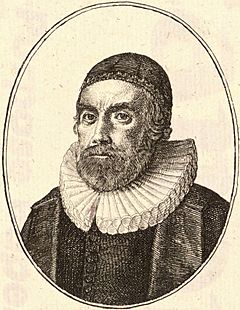

When Puritan ministers who didn't follow the rules were removed from the Church of England in the 1630s, it caused a reaction. Puritan common people spoke out against King Charles's policies. The bishops were the main target of their anger. The first and most famous critic of Laudianism was William Prynne. In the late 1620s and early 1630s, Prynne wrote many works. They criticized the spread of both Arminianism and traditional Anglicanism in the Church of England. He also opposed King Charles's marriage to a Catholic princess. Prynne became a strong critic of the loose morals at court.
Prynne also criticized society's morals in general. He wrote a book called Histriomastix. In it, he strongly attacked the theater. This book shows the peak of the Puritans' attack on English plays. Unfortunately for Prynne, his book came out around the same time that Queen Henrietta Maria performed in a play in January 1633. Histriomastix was widely seen as a Puritan attack on the queen's morality. Soon after becoming Archbishop of Canterbury, William Laud prosecuted Prynne in the Star Chamber court. He was charged with criticizing the king. Unlike regular courts, the Star Chamber could order any punishment except death. Prynne was found guilty. He was sentenced to prison, a large fine, and part of his ears were cut off.
Prynne kept publishing from prison. In 1637, he was tried in Star Chamber a second time. This time, the court ordered the rest of Prynne's ears to be cut off. He was also branded with the letters S L for "seditious libeller" (someone who writes harmful things about the government). Prynne said the letters really meant "Laud's marks." At the same trial, the Star Chamber also ordered two other critics to be punished. They were John Bastwick, a doctor who wrote against bishops, and Henry Burton.
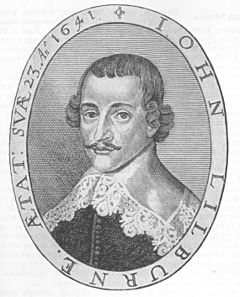
A year later, a fourth "martyr" joined them: John Lilburne. He had studied under John Bastwick. Since 1632, it was illegal to publish or import books not approved by the Stationers' Company. This allowed the government to check and censor any work before it was published. In the 1630s, Puritans often had their works published in Amsterdam. Then they smuggled them into England. In 1638, Lilburne was prosecuted for importing religious works critical of Laudianism from Amsterdam. Lilburne became known as "Freeborn John" and a champion of "English liberties." In Star Chamber, he refused to answer the charges. He said the charges were only given to him in Latin. The court then imprisoned him. Lilburne demanded to hear the charges in English. The authorities then whipped him with a three-thonged whip on his bare back. He was dragged by his hands tied to the back of an oxcart from prison to the pillory at Westminster. He was forced to stoop in the pillory, but still managed to give out unapproved books to the crowds. Then he was gagged. Finally, he was imprisoned again.
The Bishops' Wars (1638–1640)
King James had tried to bring the English and Scottish churches closer. He brought bishops back to the Church of Scotland. He also forced new rules on the Scottish church. These actions upset Scottish Presbyterians. Charles made the Presbyterians even angrier. He gave bishops in Scotland even more power than his father had. In 1635, the Archbishop of St Andrews was made Lord Chancellor of Scotland. Presbyterian opposition to Charles grew very strong in 1637. Charles tried to force a version of the Book of Common Prayer on the Church of Scotland. Scottish bishops wrote this book. But it was widely seen as an English import and called Laud's Liturgy. What was worse, where the Scottish prayer book was different from the English one, it seemed to bring back old errors. As a result, when the new Bishop of Edinburgh started to read the new liturgy in St. Giles' Cathedral, Jenny Geddes, a woman in the congregation, threw her stool at him. This started the Prayer Book Riot.

The Scottish prayer book was very unpopular with Scottish nobles and gentry. This was not just for religious reasons. It was also for nationalist reasons. The Scottish Parliament had adopted their own prayer book. But the Scottish Parliament was not asked about the new prayer book in 1637. The new book was forced on them only because Charles claimed he had supreme power in the church. This was a belief that neither the Church nor Parliament of Scotland had ever accepted. Many leading nobles wrote a document called the National Covenant in February 1638. Those who signed it are known as Covenanters. Later that year, the General Assembly of the Church of Scotland removed the bishops from the church.
To challenge this, Charles raised an army and marched on Scotland in the "First Bishops' War" (1639). English Puritans were very upset. They had long opposed bishops. Now the king was fighting a war to keep bishops in power. The First Bishops' War ended in a tie. Both sides lacked enough resources to win. Charles didn't have enough money for a war because he hadn't called Parliament since 1629. This led to the signing of the Treaty of Berwick (1639).
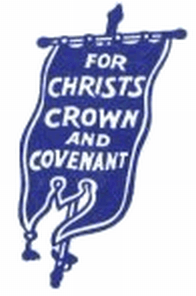
Charles planned to break the Treaty of Berwick later. When he returned to London, he started preparing to call Parliament. He wanted Parliament to approve new taxes to fund a war against the Scots. He also wanted to bring bishops back to Scotland. This Parliament, known as the Short Parliament, met in 1640. It lasted only three weeks. Unfortunately for Charles, many Puritan members were elected. Two critics of royal policies, John Pym and John Hampden, spoke out loudly against the king. These members insisted that Parliament had a right to demand that problems be fixed. They said the nation's complaints about the past ten years of royal policies should be dealt with before Parliament gave Charles the taxes he wanted. Frustrated, Charles dissolved Parliament three weeks after it opened.
In Scotland, the rebellious spirit grew stronger. After the Treaty of Berwick, the General Assembly of Scotland met in Edinburgh. They confirmed that bishops were abolished in Scotland. They went even further and said that all bishops were against God's Word. When the Scottish Parliament met later that year, it confirmed the Church of Scotland's position. The Scottish Covenanters now decided that Presbyterianism could never be safe in Scotland as long as bishops remained in England. So they decided to invade England. They wanted to help abolish bishops there. At the same time, the Scots learned that the king planned to break the Treaty of Berwick. He was going to try a second invasion of Scotland. When the Short Parliament was dissolved without giving Charles money, the Covenanters decided it was time to attack first. In August 1640, Scottish troops marched into northern England. This started the "Second Bishops' War". The Scots surprised the king and won the Battle of Newburn. The Scottish Covenanters occupied the northern counties of England. They forced the king to pay a large fine each day until a treaty was signed. The Scots believed the king could not be trusted. So they insisted that the English Parliament be part of any peace talks. Charles was bankrupt from the Second Bishops' War. He had no choice but to call Parliament to get new taxes to pay off the Scots. He reluctantly called a Parliament that would not be dissolved until 1660, known as the Long Parliament.
The Canons of 1640 and the Et Cetera Oath
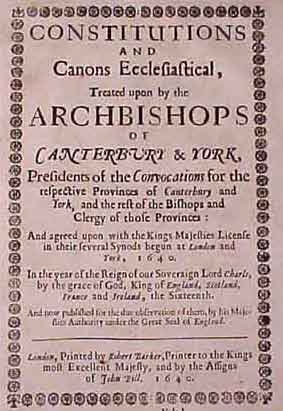
The Convocation of the English Clergy usually met when Parliament met. It was dissolved when Parliament was dissolved. In 1640, however, Charles ordered the Convocation to keep meeting. This was even after he dissolved the Short Parliament. The Convocation had not yet passed the church laws that Charles and Archbishop Laud had prepared. These laws confirmed Laudian church policies as official. The Convocation passed these laws in late May 1640.
The introduction to these laws claimed they were not new. They said they were bringing back ceremonies from the time of Edward VI and Elizabeth I. The first law said that the king ruled by divine right. It also said that the king's supreme power in the church was required by God's law. And it stated that taxes were owed to the king "by the law of God, nature, and nations." Many MPs concluded that Charles and the Laudian clergy were trying to create an absolute monarchy in England. They felt this was unwanted church interference in the recent dispute between Parliament and the king over taxes.
Laws against Catholicism and other groups were not controversial. But the law against "sectaries" was controversial because it targeted Puritans. This law condemned anyone who did not regularly attend service in their church. It also condemned those who only attended the sermon, not the full Prayer Book service. It went on to condemn anyone who wrote books criticizing the Church of England's rules.
Finally, and most controversially, the laws required an oath. It was known as the Et Cetera Oath. Many people had to take this oath. This included every clergyman, many university graduates, and schoolmasters. The oath stated:
I, A. B., do swear that I do approve the doctrine, and discipline, or government established in the Church of England as containing all things necessary to salvation: and that I will not endeavour by myself or any other, directly or indirectly, to bring in any popish doctrine contrary to that which is so established; nor will I ever give my consent to alter the government of this Church by archbishops, bishops, deans, and archdeacons, &c., as it stands now established, and as by right it ought to stand, nor yet ever to subject it to the usurpations and superstitions of the see of Rome. And all these things I do plainly and sincerely acknowledge and swear, according to the plain and common sense and understanding of the same words, without any equivocation, or mental evasion, or secret reservation whatsoever. And this I do heartily, willingly, and truly, upon the faith of a Christian. So help me God in Jesus Christ.
The Puritans were furious. They attacked the Canons of 1640 as against the law. They claimed that Convocation was no longer legally meeting after Parliament was dissolved. The effort to enforce the Et Cetera Oath met strong Puritan resistance. This was organized in London by Cornelius Burges, Edmund Calamy the Elder, and John Goodwin. The Et Cetera Oath also made Puritans even more sympathetic to the Scots. There were rumors that Puritan leaders were secretly talking with the Scottish during this time. Many Puritans refused to read the prayer for victory against the Scottish, which they had been ordered to read.
The Long Parliament Challenges Laudianism (1640–1642)
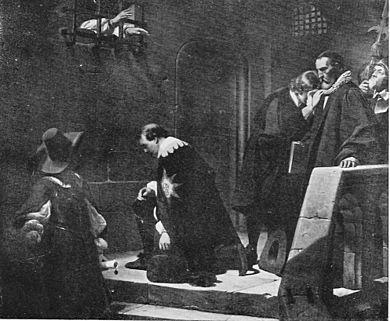
The elections for the Long Parliament in November 1640 resulted in a Parliament even more dominated by Puritans. Parliament's first task was to act against Thomas Wentworth, 1st Earl of Strafford. He had been Charles's chief governor in Ireland since 1632. After the Second Bishops' War, Strafford had been raising an Irish Catholic army in Ireland. This army could be used against the Scottish Covenanters. Puritans were horrified that an army of Irish Catholics (whom they disliked) would be used by the king against the Scottish Presbyterians (whom they supported). Many English Protestants who were not particularly Puritan felt the same way. Strafford learned that Parliament planned to remove him from office. He gave the king evidence of secret talks between Puritans in Parliament and the Scottish Covenanters. However, John Pym, along with Oliver St John and Lord Saye, skillfully managed to quickly have Parliament accuse Strafford of high treason. Strafford was arrested.
At his trial, which began in January 1641, prosecutors argued that Strafford intended to use the Irish Catholic army against English Protestants. Strafford replied that the army was meant to be used against the rebellious Scots. Strafford was eventually found not guilty in April 1641. This was because his actions did not amount to high treason. As a result, Puritan opponents of Strafford started a new legal process against him in the House of Commons. After an army revolt (the soldiers hadn't been paid), the House of Lords also passed the bill. Charles was worried the army would revolt further if they weren't paid. He knew Parliament wouldn't give money without Strafford's death. So, he signed the bill in May 1641. Strafford was executed before a crowd of 200,000 people on May 12, 1641.
The Puritans used the mood of Parliament and the public. They organized the Root and Branch Petition. It was called this because it asked for the complete removal of bishops. Fifteen thousand Londoners signed the petition. A crowd of 1,500 presented it to Parliament on December 11, 1640. The Root and Branch Petition listed many of the Puritans' complaints against Charles and the bishops. It said that bishops had silenced many good ministers. It also said ministers were afraid to teach about "predestination, free grace, perseverance, original sin remaining after baptism, the sabbath, and against universal grace." The petition condemned giving bishops worldly power. It also criticized encouraging ministers to ignore worldly authority. The petition condemned the government for stopping good books. It allowed the publication of Catholic, Arminian, and improper books. The petition also repeated several common Puritan complaints. These included the Book of Sports, placing communion tables like altars, church beautification, forcing oaths, Catholic and Arminian influence at court, and bishops misusing excommunication.
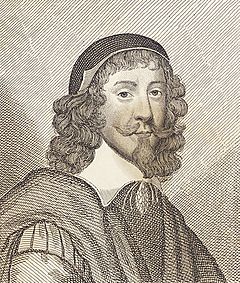
In December 1640, Parliament also accused Archbishop Laud of high treason. He was accused of destroying true religion, acting like a pope, trying to reunite the Church of England with the Roman Catholic Church, persecuting good preachers, damaging relations with other Protestant churches, promoting the war with Scotland, and other crimes. During this debate, Harbottle Grimston famously called Laud "the root and ground of all our miseries." Unlike Strafford, Laud's enemies did not quickly seek his execution. He was imprisoned in the Tower of London in February 1641.
In March 1641, the House of Commons passed a bill to stop bishops from sitting in the House of Lords. However, the House of Lords rejected this bill.
In May 1641, Henry Vane the Younger and Oliver Cromwell introduced the Root and Branch Bill. Oliver St John had written it. It was designed to completely remove bishops in England, as the Root and Branch Petition asked. Many moderate MPs were upset. They believed Charles and Laud had gone too far in the 1630s. But they were not ready to abolish bishops. The debate over the Root and Branch Bill was intense. The Bill was finally rejected in August 1641. The way MPs voted on this bill would create the main divisions in the coming war. Those who favored the bill became Roundheads. Those who defended the bishops became Cavaliers.

The debate around the Root and Branch Bill led to many pamphlets being written. Joseph Hall, the Bishop of Exeter, wrote a strong defense of bishops. Five Puritan authors responded under the name Smectymnuus. This was an acronym from their names. Their first pamphlet was published in March 1641. It is believed that John Milton, a former student of one of the authors, wrote the postscript. Milton published several pamphlets against bishops in 1640–1641. A long series of responses and counter-responses followed.
John Pym was worried that the king would quickly dissolve Parliament again. He pushed through an Act to prevent Parliament from being dissolved without its own consent. Charles desperately needed money. So he had no choice but to agree to the Act. The Long Parliament then tried to undo the most unpopular actions of the past eleven years. The Star Chamber, which had been used to silence Puritans, was abolished in July 1641. The Court of High Commission was also abolished. Parliament ordered Prynne, Burton, Bastwick, and Lilburne released from prison. They returned to London in triumph.
In October 1641, Irish Catholic nobles started the Irish Rebellion of 1641. They threw off English rule and created Confederate Ireland. English parliamentarians were terrified that an Irish army might rise to kill English Protestants. In this atmosphere, in November 1641, Parliament passed the Grand Remonstrance. This document listed over 200 points where Parliament felt the king had acted illegally during his Personal Rule. The Grand Remonstrance marked a second time when some moderate, non-Puritan MPs felt Parliament had gone too far. They thought Parliament was criticizing the king too much and showing too much sympathy for the rebellious Scots.
When the bishops tried to take their seats in the House of Lords in late 1641, a pro-Puritan, anti-bishop crowd stopped them. This crowd was probably organized by John Pym. The bill to exclude bishops was brought back in December 1641. This time, the country's mood was such that neither the House of Lords nor Charles felt strong enough to reject the bill. The Bishops Exclusion Act stopped clergy from holding any government power after February 5, 1642. This included sitting in Parliament or being part of the Privy Council. Any actions taken by clergy with such authority after that date were considered invalid.
During this time, Charles became more and more convinced that some Puritan-influenced MPs had secretly encouraged the Scottish Covenanters to invade England in 1640. This led to the Second Bishops' War. So, when he heard they were planning to accuse the Queen of being involved in Catholic plots, he decided to arrest Lord Mandeville and five MPs. These five are now known as the Five Members: John Pym, John Hampden, Denzil Holles, Sir Arthur Haselrig, and William Strode. Charles famously entered the House of Commons himself on January 4, 1642. But the members had already fled.
After his failed attempt to arrest the Five Members, Charles realized he was not only unpopular with Parliament. He was also in danger from London's pro-Puritan, anti-bishop, and increasingly anti-royal crowd. So, he and his family went to Oxford. He invited all loyal parliamentarians to join him. He began raising an army.
Parliament passed a law to raise a militia. But it said the militia should be controlled by Parliament. The king refused to sign this bill. A major split between Parliament and the king happened on March 15, 1642. Parliament declared that "the People are bound by the Ordinance for the Militia, though it has not received the Royal Assent". This was the first time Parliament said its laws could work without the king's approval. Under these circumstances, people began to choose sides: Roundheads or Cavaliers. The first clash between the royalists and parliamentarians happened in April 1642. This was the Siege of Hull. It began when the military governor appointed by Parliament refused to let Charles's forces get military supplies. In August, the king officially raised his standard at Nottingham. The First English Civil War had begun.
The Westminster Assembly (1643–1649)
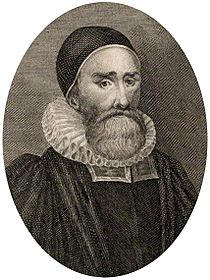
In 1642, the strongest supporters of bishops in the Long Parliament left to join King Charles in the war. However, even though Civil War was starting, Parliament was at first unwilling to pass laws without the king's approval. So, between June 1642 and May 1643, Parliament tried five times to pass laws for a religious assembly. But these bills did not get the king's approval and failed. By June 1643, Parliament was ready to defy the king. They called a religious assembly without his consent. This assembly, the Westminster Assembly, first met in Westminster Abbey on July 1, 1643.
The Assembly was tasked with creating a new church service book to replace the Book of Common Prayer. It also had to decide what kind of church government was right for the Church of England. In both cases, it was understood that the Westminster Assembly would only make suggestions. Parliament would have the final say.
The Long Parliament appointed 121 divines (theologians or clergy) to the Westminster Assembly. About 25 of them never attended. This was mainly because King Charles ordered all loyal subjects not to take part. To replace those who didn't attend, Parliament later added 21 more divines. The Assembly also included 30 lay assessors (10 nobles and 20 commoners). Although the Westminster Divines were mainly Puritan, they represented many different views in the Church of England (except Laudianism).

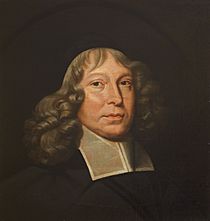
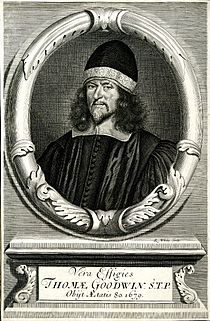
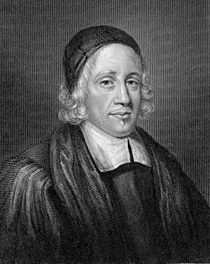
For its first ten weeks, the Westminster Assembly only revised the Thirty-Nine Articles. However, in summer 1643, Parliament's forces, led by John Pym and Henry Vane the Younger, made an agreement with the Scots. This was called the Solemn League and Covenant. One main reason the Scots started the Second Bishops War in 1640 was to end bishops in England. So they insisted that England agree to fight to remove "Catholicism and bishops." Since the Puritans also wanted to fight these things, they agreed. The Long Parliament agreed to swear to the Scottish National Covenant. Six Commissioners from the Church of Scotland were then sent to the Westminster Assembly. On October 12, 1643, the Long Parliament ordered the Assembly to "discuss a church system that would best agree with God's holy word." This system should also bring peace to the church at home and closer agreement with the Church of Scotland and other Reformed Churches abroad.
Groups at the Westminster Assembly
The Westminster Assembly's talks about church government were a turning point for Puritans. Before, Puritans had been united against the king's and bishops' church policies. Now, they became divided over reforms to the Church of England. The Westminster Divines split into four groups:
- The Episcopalians, who supported a moderate form of church government with bishops. They were led by James Ussher, Archbishop of Armagh.
- The Presbyterians, who favored a church government run by elders and assemblies. The Scottish Commissioners, especially George Gillespie and Samuel Rutherford, strongly pushed this view. The most influential Englishman in this group was probably Edward Reynolds.
- The Independents, who favored a church government where each local church (congregation) was independent. They were led by Thomas Goodwin.
- The Erastians, who believed that church government was not fixed by divine law. They thought the state should decide it. They were led by John Lightfoot.
Many issues divided the groups:
- Is church government fixed by divine law or can it be chosen? The Erastians argued most strongly that church government was not fixed by divine law. They believed each national church could choose its own. Other groups were more likely to believe their positions were based on the Bible.
- How much hierarchy should there be in the church? Episcopalians believed the church should be organized in a hierarchy, with bishops overseeing other clergy. Presbyterians believed the church should be organized in a hierarchy of assemblies (local meetings, regional meetings, larger meetings, and a top General Assembly). While this involved hierarchy, they stressed it wasn't about individuals being higher than others. Independents opposed all forms of hierarchy. They argued that ministers should only answer to their local churches.
- The proper relationship between church and state: All groups rejected the "Catholic" idea that church and state should be united with the state under the church. Erastians and many Episcopalians believed church and state should be united, but with the church under the state. Presbyterians argued for complete separation of church and state. But they still felt the state should enforce religious uniformity. Independents went furthest, arguing for both separation of church and state and religious liberty.
- Should the church's services be uniform? Those who liked bishops favored services similar to the Book of Common Prayer. This would be revised to be acceptable to more Puritans. But it would still have set prayers used everywhere. Those who liked Presbyterianism preferred something like Knox's Book of Discipline. This set out the general form of worship. But it allowed individual ministers to write their own prayers or pray without a script. Independents were more likely to oppose all set forms of worship. They accepted local differences in worship. They felt almost all prayer should be spontaneous.
The Erastian Controversy (1645–1646)
For the next two years, another debate took up the Assembly's time: the Erastian Controversy. This was about the proper relationship between church and state.
During the time of Queen Elizabeth I, two Acts of Parliament set the place of the Church of England. The first declared the monarch to be the Supreme Governor of the Church of England. It required everyone to swear they recognized the king's supreme power in the church. The second established religious uniformity by requiring all churches to use the Book of Common Prayer.
The events of the 1640s made English lawyers worry. They feared the Westminster Assembly was preparing to illegally change the church in a way that would override the king's supreme power. So, John Selden, a leading lawyer, led a campaign against changing the Church of England in a way that would weaken the king's power. Just as the Presbyterian group in the Assembly was led by Scots, the Erastian group was led by Selden and other lawyers. Selden argued that not only English law, but the Bible itself, required the church to be under the state.
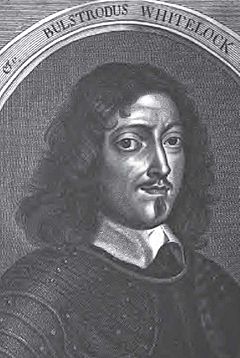
Starting in April 1645, the Assembly focused on the Erastian Controversy. Besides John Lightfoot, the most eager supporter of the Erastian position was Bulstrode Whitelocke. He was one of the MPs serving as a lay assessor to the Assembly. Whitelock argued that only the state, not the church, could legally use the power of excommunication (removing someone from the church).
In October 1645, the Scottish Commissioners succeeded. The Long Parliament voted for a law setting up a Presbyterian church government in England. However, they were shocked that Parliament also adopted the Erastian argument. It made any final church decision on excommunication appealable from the General Assembly to the Parliament of England.
This decision caused protests from the Presbyterian group. The Parliament of Scotland worried that the Long Parliament was not keeping its promises. It protested the Erastian nature of the law. London ministers organized a petition to Parliament. The Westminster Assembly responded by sending a group, led by Stephen Marshall, to protest the Erastian nature of the law. Parliament responded by sending a group to the Westminster Assembly. They brought a list of questions about whether church government was fixed by divine law. The Assembly flatly rejected the Erastian position. Only John Lightfoot and Thomas Coleman spoke in favor of it.
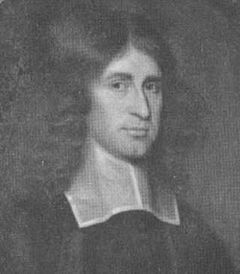
The Presbyterian group started a huge public campaign. In 1646, many major defenses of Presbyterianism were published. One Scottish Commissioner, Samuel Rutherford, published a book called The Divine Right of Church Government and Excommunication. Another Scottish Commissioner, George Gillespie, debated with Coleman in pamphlets. Gillespie also criticized William Prynne, who had written in favor of Parliament's law. Prynne was a special target when Gillespie wrote his major work, Aaron’s Rod Blossoming.
The Presbyterian group also used their strength in London to petition Parliament for their position.
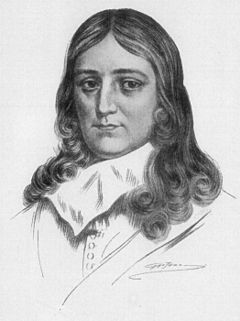
In August 1645, Parliament had passed a law to set up elders throughout the country. But it had not given instructions on how to do this. On March 14, 1646, Parliament passed a new law. This law provided ways to select elders throughout the country. It generally set up a Presbyterian system of church government. However, this law again contained an Erastian element. It created a new office of "commissioners to judge of scandalous offenses." These commissioners could decide if a "scandalous offense" deserved excommunication. Church meetings were forbidden from excommunicating any member without a commissioner's approval. The Presbyterian group was furious about the inclusion of this office.
The Independent group was angry that Parliament kept enforcing religious conformity. The most famous expression of the Independents' sadness was John Milton's poem "On the New Forcers of Conscience under the Long Parliament." Milton argued that the Long Parliament was copying Catholic tyranny in the church. He said it was breaking the biblical idea of Christian liberty. He also said it was punishing good people. He ended the poem with the line, "New Presbyter is but old Priest writ large." This was a play on words, suggesting the new Presbyterian leaders were just as bad as the old Catholic or Laudian priests.
The Westminster Standards (1641–1646)
While the Westminster Assembly debated church government, they also reviewed worship and doctrine. These parts caused less disagreement among the divines.
Tasked with reforming English church services, the Assembly first thought about simply adopting John Knox's Book of Common Order. But the Assembly rejected this idea in 1644. The job of creating a new service book was given to a committee. This committee drafted the Directory of Public Worship. The Westminster Assembly passed it in 1645. Unlike the Book of Common Prayer, which had detailed rules for how clergy should conduct services, the Directory of Public Worship is a loose guide for worship. It expected the minister to fill in the details. Under the Directory, the main focus of the service was preaching.
The service began with a Bible reading. This was followed by an opening prayer (chosen, written, or spoken spontaneously by the minister). Then came a sermon. The service ended with a closing prayer. The Directory gave guidelines for what prayers and sermons should contain. But it did not have any set forms of prayers. The Directory encouraged public singing of psalms. But it left it up to the minister to decide which psalms to use and when. The sections on baptism, communion, marriage, funerals, and days of public fasting or thanksgiving were similar.
In 1643, the Long Parliament ordered the Westminster Assembly to write a new Confession of Faith and a new national catechism. The result was the Westminster Confession of Faith and two catechisms. The Westminster Larger Catechism was meant to be complete. The Westminster Shorter Catechism was designed to be easier for children to memorize.
The Long Parliament approved the Directory of Public Worship in 1645. The Westminster Confession was presented to Parliament in 1646. But the House of Commons sent it back. They instructed the Assembly to add Bible verses to support the Confession. This version was sent back to Parliament in 1648. After much debate, the Confession was approved by the Long Parliament. Some chapters and sections approved by the Assembly were removed. The Larger Catechism was finished in 1647. The Shorter Catechism was finished in 1648. Both were approved by the Westminster Assembly and the Long Parliament.
The Westminster Standards had been created with the help of the Scottish Commissioners. So the Scots had no problem approving them. This helped Scotland keep its promise to England under the Solemn League and Covenant. Since the Directory created a type of church government already used in the Church of Scotland, the General Assembly of the Church of Scotland quickly approved it. Then the Parliament of Scotland approved it in 1646. The Larger and Shorter Catechisms were approved by the General Assembly in 1648. The Westminster Confession was approved in 1649. The Westminster Standards are still used by the Church of Scotland and almost all Presbyterian churches today.
Its work finished, the Westminster Assembly was dissolved in 1649.
Oliver Cromwell and the New Model Army
At first, Parliament's forces did not do well against the royalist forces. The first major battle, the Battle of Edgehill in October 1642, was undecided. So was the First Battle of Newbury in September 1643. Because they failed to defeat the king, Parliament made an alliance with the Scots. This led to the Solemn League and Covenant. Parliament agreed to set up Presbyterianism in England. The war was put in the hands of a joint Scottish and English committee. With the Scottish forces, the parliamentarians won a big victory at the Battle of Marston Moor in July 1644.

The most successful parliamentary cavalry commander was Oliver Cromwell. Cromwell proposed an idea to the committee. He believed the current military system was not working. It relied on local militias defending local areas. Cromwell suggested that Parliament create a new army. This army could be sent anywhere in the kingdom and would not be tied to one place. After the Second Battle of Newbury in October 1644, Cromwell pushed his idea even harder. In that battle, Parliament's forces greatly outnumbered the royalists. Yet, they barely won. At this point, most leaders in the parliamentary army were Presbyterians. They supported the Presbyterians at the Westminster Assembly. Cromwell, however, sided with the Independents. Cromwell thought the Presbyterians in the army, especially his superior, Edward Montagu, 2nd Earl of Manchester, opposed his idea. He believed they wanted to make peace with the king. He also thought the army's supreme commander shared Manchester's views. Cromwell felt Parliament should seek total victory over the royalists. He did not trust Charles, so he thought Charles should have no role in any post-war government.
Cromwell was an MP and a military commander. He outsmarted his enemies in the army. On December 9, 1644, Cromwell introduced a bill in Parliament. It said that no member of either the House of Commons or the House of Lords could keep their military command while also being an MP. Members would have to choose. Cromwell's bill passed the House of Commons. But the House of Lords rejected it in January 1645. They worried this would mean no nobleman could command the army. To ease this worry, Cromwell brought back his bill. It included a rule that Parliament could re-appoint any parliamentarian to the army if they resigned from Parliament. The Lords were eventually convinced. On January 13, 1645, they passed this bill, known as the Self-denying Ordinance.
Around the same time, on January 6, 1645, the committee approved Cromwell's request. They authorized the creation of the New Model Army. After the Self-denying Ordinance, the previous commanders resigned from the army. They wanted to keep their positions in the House of Lords. Cromwell, instead, resigned from the House of Commons. He did not want to lose his army position. So, when the New Model Army was organized under Sir Thomas Fairfax, Cromwell was the most senior army commander left. Fairfax relied on Cromwell as his second-in-command. Cromwell worked to ensure no Presbyterians were recruited to the New Model Army. He encouraged Independents to join. Cromwell had created a situation where Presbyterians controlled the Long Parliament. But Independents controlled the New Model Army.
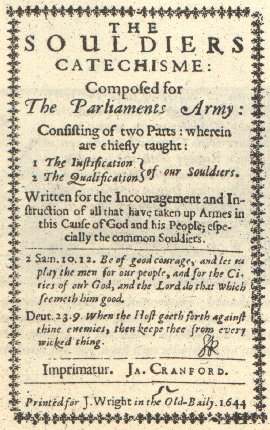
At the Battle of Naseby on June 16, 1645, the New Model Army won a decisive victory over royalist forces. Several more battles were needed to defeat the royalists. In May 1646, Charles surrendered to Scottish forces.
By early 1647, the leaders of the Long Parliament and the Scots wanted peace with Charles. They wanted to restore Charles to power as a king with limited power. But Oliver Cromwell, the Independent leader of the New Model Army, wanted to get rid of Charles. The Scots and the Presbyterian group at the Westminster Assembly wanted a pure Presbyterian church in England. But the Long Parliament had created a form of Presbyterianism that had elements the Presbyterians and Scots disliked. So, the Scots and the Presbyterian group decided to approach the king. They wanted his support against the Independents and the others.
The Second English Civil War (1648–1649) and the King's Execution (1649)
In summer and fall 1647, Henry Ireton and John Lambert negotiated with Parliament. Eventually, the Army and Parliament agreed on a set of proposals. These were known as the Heads of Proposals. They were presented to Charles in November 1647. The main ideas were:
- Royalists had to wait five years before holding office.
- The Book of Common Prayer could be read but was not required. No penalties for not going to church or attending other services.
- The current Parliament would set a date for its end. After that, Parliaments would be called every two years. They would meet for at least 120 days and no more than 240 days. Voting areas would be reorganized.
- Bishops would remain in church government, but their power would be greatly reduced.
- Parliament would control the appointment of state officials and army/navy officers for 10 years.
Charles, however, rejected these proposals.
Instead, Charles negotiated with a group of Scottish Covenanters. On December 26, 1647, he signed a secret treaty with them. This group became known as the Engagers. Under this agreement, Charles agreed that bishops should be removed from the Church of England. He also agreed to support Presbyterianism for three years. After that, a permanent solution for the church's government could be worked out. In exchange, the Engagers agreed to bring an army of 20,000 into England. They would suppress the New Model Army and restore Charles to the throne. This led to the Second English Civil War. The royalist forces were decisively defeated at the Battle of Preston in August 1648.
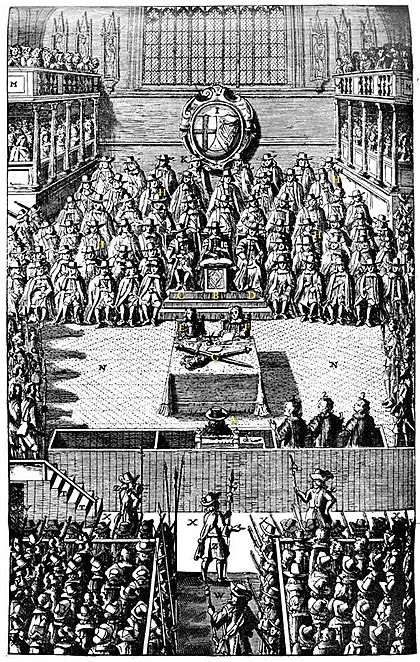
The Independents in the Army argued that the King was a "man of blood" who deserved to be punished. They said the outcome of the First English Civil War showed God's judgment against Charles. Fighting again after that judgment meant shedding innocent blood. The army leaders wrote The Remonstrance of the Army in November 1648. It called on the Long Parliament to execute Charles. It also asked to replace the king's family rule with an elected monarchy. When the Long Parliament rejected the Army's request, the Army Council took strong action.
On Wednesday, December 6, Colonel Thomas Pride’s soldiers took positions on the stairs to the House of Commons. Pride stood at the top. As MPs arrived, he checked them against a list. Lord Grey of Groby helped identify who should be arrested or stopped from entering. This event, known as Pride's Purge, removed all but about 200 of the 500 members.
After the Purge, the remaining members (who supported the Independent party and the Army Council) were known as the Rump Parliament. They proceeded to do what the Long Parliament had refused: put Charles on trial for high treason. The House of Commons passed an act on January 3, 1649. It created a special court for Charles I's trial. The House of Lords rejected this act. But the Army insisted the trial go ahead. It began on January 20, 1649, and ended on January 27, 1649, with a guilty verdict. Fifty-nine Commissioners signed Charles's death warrant. He was beheaded on January 30, 1649.
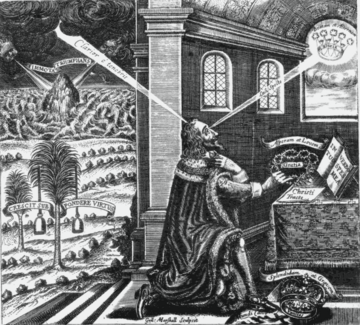
The execution of Charles I shaped how the Puritan movement was seen for generations. To its opponents, this outcome confirmed that Puritanism led to violent rebellion. They saw a direct link from religious extremism to killing the king. The largest group of Puritans, the Presbyterians, had actually opposed the king's execution. But to the king's supporters and those who favored bishops, this difference seemed too small. For many Independents, the execution was completely justified. Charles was a ruler who had defied God's will and had to be punished.
Books and writings about the king's execution appeared after royalists published Eikon Basilike right after Charles's death. Eikon Basilike claimed to be written by Charles during his time in prison. But it was almost certainly written by someone else, likely John Gauden. The book presented Charles as a "devout son of the Church of England." It said he was unfairly hunted by Puritan persecutors and killed for defending the Church of England against extremists. John Milton, now the most important Independent writer, responded later in 1649. He wrote a book called Eikonoklastes. This book was a point-by-point response to Eikon Basilike's flattering picture of Charles and its negative picture of the Parliamentarians and the Army.
Images for kids
-
The Synod of Dort, painted in 1721 by the Arminian Abraham van der Eyk. It depicts what many Arminians thought about the Synod: the Bible on the Arminian side is outweighed by Calvin's Institutes on the other, along with a sword representing the power of the state.
-
John Pym (1584–1643), Puritan MP who spoke out against Richard Montagu in 1625
-
William Laud (1573–1645), Archbishop of Canterbury from 1633 to 1645; a close advisor to Charles I, and architect of Laudianism, was executed by Parliament in 1645.
-
John Winthrop (1587/8–1649), Governor of the Massachusetts Bay Colony, who led the Puritans in the Great Migration, beginning in 1630.
-
William Prynne (1600–1669), Puritan politician who opposed the policies of William Laud, Archbishop of Canterbury
-
...and Henry Burton (1578–1648).
-
... as did John Bastwick (1593–1654)...
-
John Lilburne (1614–1657), Puritan layman who, in 1638 gained national frame as "Freeborn John" for his defense of himself when called before Star Chamber to defend his importing unlicensed publications from Amsterdam.
-
Richard Sibbes (1577–1635) served as one of the Feoffees for Impropriations, who were organized in 1625 to support Puritanism in the Church of England, and which were dissolved with their assets forfeited to the crown in 1632.
-
Jenny Geddes throws her stool at David Lindsay, Bishop of Edinburgh, in 1637, setting off the Prayer Book Riot which would ultimately lead to the First Bishops' War.
-
The blue banner carried into battle by the Covenanters from 1639.
-
Title page of the Canons of 1640, which were passed by the Convocation of the English Clergy at the behest of King Charles and Archbishop Laud and which were detested by the Puritans.
-
In the early days of the Long Parliament, Puritans led the charge in the impeachment of both Archbishop Laud and Thomas Wentworth, 1st Earl of Strafford. This 19th-century painting by Paul Delaroche shows Laud reaching his hands from his cell in the Tower of London to offer Strafford a blessing shortly before Strafford's execution in May 1641. Laud would subsequently be executed in 1645.
-
Oliver St John (c. 1598–1673), who drew up the Root and Branch Bill, which would have finally abolished episcopacy. The bill was introduced in Parliament by Henry Vane the Younger and Oliver Cromwell in May 1641, and defeated in August 1641.
-
Edmund Calamy the Elder (1600–1666), the "E.C." in Smectymnuus, a group of Puritans who wrote in response to Bishop Hall's defense of episcopacy in 1641.
-
William Twisse (1578–1646), who was elected as the first Prolocutor of the Westminster Assembly in 1643, and who held that position until his death.
-
James Ussher (1581–1656), Archbishop of Armagh, who pushed for a moderate form of episcopacy at the Westminster Assembly.
-
Samuel Rutherford (c. 1600–1661), Scottish Commissioner to the Westminster Assembly, who played a crucial role in ensuring that the Assembly ultimately came out in favour of presbyterianism.
-
Thomas Goodwin (1600–1680), one of the "Five Dissenting Brethren" and a leader of the Independents in the Westminster Assembly.
-
John Lightfoot (1602–1675) believed that ecclesiastical polity was not a matter of a divine law and that the church should be subordinate to the state, a position known as Erastianism at the Westminster Assembly.
-
Bulstrode Whitelocke (1605–1675), MP who attended the Westminster Assembly as a lay assessor and who played a crucial role in ensuring that when the Long Parliament adopted presbyterianism for the Church of England, it did so in an Erastian way.
-
George Gillespie (1613–1648), Scottish Commissioner to the Westminster Assembly who wrote Aaron's Rod Blossoming, one of the most important defenses of presbyterian polity.
-
John Milton (1608–1674), an Independent who wrote a famous poem "On the New Forcers of Conscience under the Long Parliament" denouncing the Long Parliament for not adopting religious liberty in 1645.
-
Oliver Cromwell (1599–1658), parliamentary commander who came to favor the Independents, and who brilliantly convinced the Long Parliament to pass the Self-denying Ordinance, as a result of which he was able to ensure that when the New Model Army was organized in 1645, it was dominated by Independents.
-
The Soldier's Catechism, which set out the rules and regulations of the New Model Army.
-
Print depicting the trial of Charles I (1600–1649) in 1649. While opposition to putting Charles on trial was strong, the Independents in the New Model Army insisted on a trial, and then an execution, and purged the Long Parliament so that the trial and execution could go ahead.
-
Frontispiece of Eikon Basilike, a book purportedly by King Charles (1600–1649), but likely ghost-written by John Gauden (1605–1662) and which appeared immediately after Charles' execution in January 1649. Eikon Basilike portrayed Charles as a Christian saint who had been martyred for defending episcopacy in the Church of England against Puritan fanatics.


